
views
X
Trustworthy Source
US Department of Labor
Federal department responsible for promoting the wellbeing of workers
Go to source
Educating Employees

Include FMLA information in your employee handbook. Your employee handbook should provide basic information about what the FMLA covers, how to request leave, and how FMLA requests affect other benefits your employees may be offered. If you are covered by the FMLA, your employees become eligible for benefits once they have worked at least 1,250 hours over a 12-month period of time. Reasons for FMLA leave include the birth of a child, a serious medical condition that renders the employee unable to work, or the need to care for an immediate family member with a serious health condition. You can use the DOL's FMLA fact sheet to satisfy this requirement. This fact sheet is available for download at http://www.dol.gov/whd/regs/compliance/whdfs28.htm. The DOL also has an employee guide that explains the FMLA and answers some frequently asked questions about eligibility, rights, and benefits. You can download the guide at http://www.dol.gov/whd/fmla/employeeguide.pdf. Either you or the employee may choose to substitute accrued paid leave in place of FMLA leave. If you require such a substitution to be made, this requirement should be included in your employee handbook.

Train managers and supervisors to handle leave requests. Because employees aren't required to indicate they are requesting leave under FMLA, your supervisory employees need to know what the FMLA covers and how to recognize those requests. Go over forms and required notices in detail so managers and supervisors know how to provide notice as required by FMLA, and the deadlines for providing that notice. Your managers and supervisors should know how to calculate the 12-month leave year for FMLA purposes. As an employer you can choose one of four methods, but you must apply the method you choose consistently – you can't choose one method for some employees and a different one for others. Generally, you may measure the 12-month period by using the calendar year, a fixed 12-month "leave year" period, a 12-month period measured from the date of an employee's first FMLA leave period begins, or a period measured from the first date an employees uses any FMLA leave.
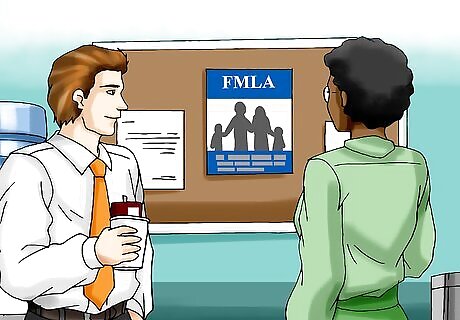
Display required posters in the workplace. The DOL has posters providing basic information about employee rights under the FMLA that must be displayed in all covered workplaces. The poster explains the provisions of the FMLA and tells employees how to file a complaint with the DOL if their employer violates the act. You must display the poster in a place where employees and applicants can easily see and read it, and it must remain up even if you don't currently have any employees who are eligible for FMLA leave. You can download and print a copy of the poster at http://www.dol.gov/whd/regs/compliance/posters/fmla.htm. If you have employees who are not literate in English, you must provide the poster in the language in which they are literate.
Keeping Adequate Records

Maintain accurate and complete payroll records. Under the FMLA, your payroll records must meet the same standards set in the Fair Labor Standards Act (FLSA). Payroll records must include identifying information, rate of pay, terms of compensation, hours worked, other compensation, and total compensation paid to each employee. When an employee returns from FMLA leave, he or she must be restored either to the same job or one that is virtually identical in terms of pay, benefits, and other terms of employment. Complete records must be kept for at least three years.
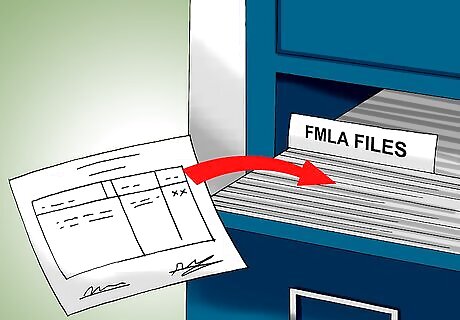
Create FMLA files when leave is requested. When employees exercise their rights under FMLA, keep the documents in one place. Your file should include the dates and hours of FMLA leave taken, as well as any other employee benefits or leave hours used. Each employee is only entitled to 12 weeks of leave per 12-month period. You are responsible for keeping accurate records for each employee so you know how much leave he or she has available when a request is made. Include any written requests from the employee, as well as copies of all notices sent to the employee regarding his or her leave. You are allowed to request medical certification of the employee's condition. If you request medical certification you must give the employee 15 days to provide it. If you require period status updates or certification of the employee's fitness to return to work, include copies of these reports with your other FMLA paperwork. Any documents related to a medical certification or medical history of an employee or an employee's family members should be maintained as confidential records separate from other FMLA records.

Document all FMLA disputes. If you deny an employee's FMLA request, make sure the reasons for that denial are documented and any additional paperwork is kept. Employees may either file a private lawsuit or a complaint with the DOL if they are unsatisfied with your response to FMLA requests. You will need this documentation to defend your actions, particularly if you denied an employee leave. Keep in mind that the FMLA requires all notices to employees to be in writing, and to be delivered within a particular period of time. In the event an employee disagrees with your actions regarding his or her leave request, you will need to prove that you provided the proper notices within the deadlines established by the FMLA. #Update personnel files with details regarding benefits. Each employee's file should include details about the employer-provided benefits he or she has accrued. If the employee is receiving benefits such as insurance, these must be maintained while the employee is on FMLA leave. You can require the employee to continue to pay his or her portion of any premiums, and it is the employee's responsibility to make arrangements to do so. Maintain records of all premium payments to comply with this FMLA requirement. If the employee fails to pay his or her premiums as agreed while on leave, you and the insurance carrier have the right to discontinue coverage. If the employee fails to return to work after taking FMLA leave, you may be able to recover premiums you paid during the leave period.
Responding to Leave Requests

Consider requiring written notice from employees. Although not required by the FMLA, requiring written notice enables you to document all requests accurately and maintain complete records. If the employee's need for leave is reasonably foreseeable, you may require 30 days written notice of any FMLA request. Where the need is not foreseeable, such as in a medical emergency, the employee still must provide you notice as soon as possible. Employee notice must include sufficient information for you to understand that his or her leave is covered by FMLA.

Evaluate employee leave requests promptly. If an employee requests leave that could implicate the FMLA, you only have a few days after receipt of the request to respond. Since employees are not responsible for indicating whether they intend to use FMLA, anyone who regularly accepts employee leave requests must know how to quickly review an employee request and determine whether the FMLA applies. Depending on the size of your business, you may want to consider designating a single manager or supervisor to handle all FMLA requests.

Send designation notices where appropriate. Employees who don't indicate they are requesting leave under FMLA must be notified if you elect to designate it as such. Employees must be notified in advance if the leave they've requested is being counted against their FMLA time. Even if you later learn that leave the employee took previously qualified under FMLA, you can't go back and retroactively designate it as FMLA leave. Only one such notice is required for each qualifying reason within a 12-month period of time.
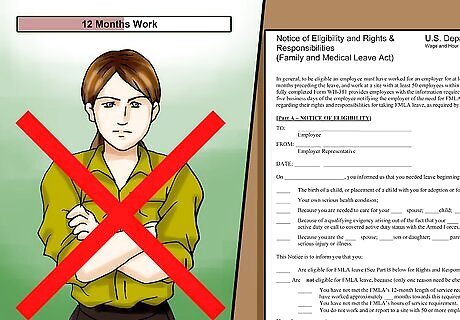
Provide complete descriptions of employees' rights and responsibilities under the FMLA. Within five business days of the employee's request, you must send him or her an eligibility notice that outlines the employee's expectations and obligations, and the consequences for failure to fulfill any of those obligations. This notice generally must state whether the employee is eligible for FMLA leave, and if not eligible include at least one reason. For example, if you hire an employee in January and she requests leave to care for her mother in August of the same year, you would send her an eligibility notice stating she was ineligible for FMLA because she had not worked for you for 12 months. The DOL has a pre-printed form you can fill out and use to satisfy this notice requirement. You can download the form at http://www.dol.gov/whd/forms/wh-381.pdf. The rights and responsibilities notice must include the amount of leave the employee has available under the FMLA, how much of his or her requested leave will count against the FMLA entitlement, and any requirements regarding certification of the employee's medical condition, payment of health insurance premiums, or substitution of paid or accrued leave.












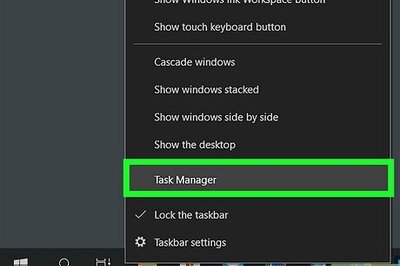






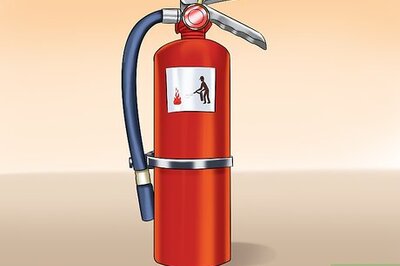
Comments
0 comment